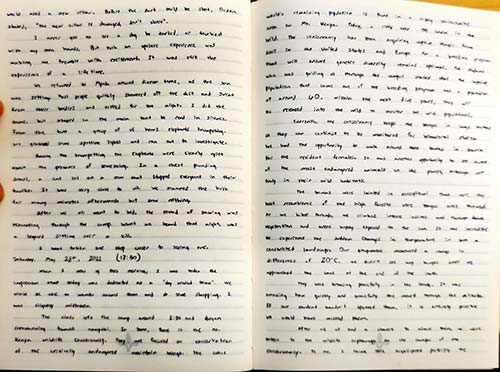The Wyoming Wild Podcast:
Exploring Savana Ecology on UW's Kenya Field Course at the Mpala Research Center
In this episode, we interview Professor Jake Goheen, instructor of the "Ecology and Conservation of African Savannas" field course, and three students from the program, Ema Lujan, Angela Zhu, and Dill Scherer. The course was organized by personnel from the UW Department of Zoology & Physiology, and took place from May 19 to June 7 at the Ewaso Ng’iro campsite on the grounds of Mpala Research Centre in Laikipia County, Kenya.
The course aimed to provide unique learning opportunities to UW students that are not currently available on campus, exposing them to study formulation, data analysis, and field practices in wildlife ecology in a one-of-a-kind setting. Twelve UW students and two Kenyan students were immersed in the study of the ecology and conservation of savanna wildlife, learning from professors, graduate students, and local experts in the conservation of endangered species.
The Mpala Research Centre was the logistical hub for the field course, situated within the 48,000 acre Mpala Conservancy, and providing 24-hr security and basic science facilities consisting of labs and associated infrastructure. The course consisted of a combination of short lectures, field observations, hands-on field techniques, exchanges with people from local villages, student-driven research projects and presentations, and wildlife viewing.
Throughout the course, students gained knowledge and further appreciation for the ecology and conservation of savanna wildlife, as well as an understanding of the challenges and opportunities inherent to research in wildlife ecology and conservation. They also used case studies in savannas to comprehend classic and contemporary issues in the conservation, ecology, and evolution of biodiversity, with emphasis on mammals and birds, and gained experience in a variety of field techniques for sampling biodiversity.
The program was partly funded by the UW Department of Zoology and Physiology, the UW College of Arts and Sciences, the UW Global Engagement Office, and the UW Biodiversity Institute, with expenses associated with two Kenyan students fully funded by the Mpala Research Centre. The staff at the Ewaso Ng’iro campsite were also responsible for keeping the students safe and well-fed throughout the course.
Join us as we dive deeper into the experiences and insights gained by Professor Goheen and his students during this once-in-a-lifetime field course in the African savannas.
Field Course Results in Published Research on Ant-Tree Mutualism
Four University of Wyoming undergraduate students, Ema Lujan, Ryen Nielsen, Zoe Short, and Samuel Wicks, recently had their independent research project conducted during their field course to Kenya published in a scientific journal. The study, partially supported by the Biodiversity Institute, led by former UW grad student and current University of Arizona professor Dr. Jesse Alston, explores how an ant-tree mutualism influences songbirds' nest selection. The research reveals that four ant species defend whistling-thorn trees from elephants, and the varying aggressiveness of these "bodyguard" ants influences songbirds' nesting preferences, shedding light on intricate ecological interactions in the African savanna. These ant "bodyguards" vary in their aggressiveness not only to elephants, but to any other critters in close proximity to trees. As such, songbirds go out of their way to nest in trees with the less-aggressive bodyguards, and avoid nesting in trees with more-aggressive bodyguards.
Learn More: The Mpala Research Center and Conservancy
The Mpala Research Center was established in November 1994 at the core of the Ewaso ecosystem, a large, geographically diverse region of central Kenya, defined by the Ewaso Ng’iro River and it’s tributaries. The region is characterised by arid and semi-arid savannahs and woodlands, having an estimated 550 bird species and 100 mammal species, including large populations of elephants and rare species, such as the Grevy’s zebra, reticulated giraffe, and African wild dog. The region is unique in that little of it is formally protected, yet wildlife abundance rivals the renowned Maasai Mara and Serengeti ecosystems. The Mpala property is located on the Laikipia Plateau and has grown to be over 48,000 acres. It is a hub for experimental and manipulative research by visiting scientists and students. Mpala provides a ‘living laboratory’ without the restrictions of a national park, allowing scientists to manipulate the environment and conduct landscape-level, controlled experiments to explore basic science, address real-world problems, and ensure that sustainable livelihoods and economic advancement are synonymous with wildlife conservation.



